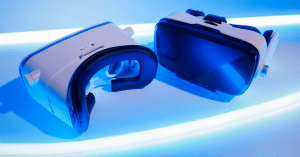There is significant overlap in some of the technologies and use cases of augmented reality (AR) and virtual reality (VR), but there are still big differences between the two.
VR creates a completely simulated environment that immerses the user in a virtual world. The virtual world is created via software and then displayed to the user using some type of headset. The entire view that the user sees is a computer generated simulation.
By contrast, AR starts with the real world environment and then blends in digital information, to augment the user’s existing view of the physical world. This digital information could be textual information, image overlays, or even virtual objects. The digital augmentation is created via software and then projected into the physical world using a variety of hardware approaches.
So what are the advantages of each technology, and how can they be used?

Advantages of VR:
Practical VR systems have been around for longer than AR, and have a few interesting advantages.
1. VR can create a completely immersive experience
The ability to create a completely virtual environment and immerse the user in it can be very powerful. This is especially useful for simulations and training exercises, where users can be placed in lifelike environments to learn and practice new skills. The artificial environment can also create an entertaining way for users to mentally escape their current physical location.
Immersive virtual environments are especially interesting in the potential they have to put users on the same ‘level playing field’ regardless of where they are located in the world. Whether for gaming, training, or working remotely, users can collaborate or compete and have almost exactly the same experience as someone in a very different physical environment.
When communicating or working in a team, users can choose their own virtual characters or avatars to represent themselves instead of needing to be on camera. This also presents an interesting opportunity to reduce unconscious bias in communications, as it potentially allows VR users to be represented by their track record regardless of their personal looks
2. VR requires fewer sensors and less processing power than AR
Since virtual reality involves generating immersive virtual worlds, it’s counterintuitive that it is easier on computing resources than AR. However, virtual reality only needs to generate a single virtual world that can react to inputs from the user. This makes VR simpler and less resource intensive than AR, which must simultaneously execute all of the following tasks:
- Generate a virtual world (or some type of software information overlay)
- Use sensory devices to track the user’s position and orientation in the real world
- Map the augmented digital content onto the real world
Generating a single virtual world is a much simpler problem than mapping the real world and tracking the user’s movements in it. This generally makes VR systems less computationally intensive, and therefore generally easier to develop and deploy. This could change over time as computer vision and software models enable AR technology to operate more efficiently.
Use Cases for VR:
There are so many potential use cases for virtual reality that we’ve created a separate article on this topic, but at a glance here are a few common use cases.
- Immersive gaming
- Training and simulation
- Product visualization
- Remote work
- TV and movies
- Immersive travel experiences
- Therapy for trauma and PTSD
Many forms of entertainment like video games and even movies involve an aspect of bringing the user on a mental journey to a completely fictional world. Virtual reality gaming is one of the most popular uses of VR technology. VR games can provide a very immersive and realistic gaming experience that feels much more ‘real’ than traditional video games because of the their ability to virtually transport the user to an alternate world.
Some VR systems are also being used to create immersive movie experiences. These systems use special headsets and sensors to track the user’s movements and place them in a simulated environment that is synchronized with the movie. The result is a much more immersive experience that can make even familiar movies feel fresh and new.
Advantages of AR:
1. AR systems can be used without blocking out the real world
One hazard of VR devices is that they require clearing out a safe area where the user can move around without running into obstructions in the real life environment. With augmented reality, users can still see the world around them which means they can still walk (or drive) around while using AR devices. Since AR also enables experiences that won’t obscure the view of the user, this can facilitate face-to-face communication while still incorporating aspects of the digital world.
2. AR is less likely to cause motion sickness than VR
Related to the item above, because the user typically remains grounded in real world objects and surroundings, the effects of motion sickness or simulation sickness are reduced.
3. AR can provide more contextual information than VR
Augmented reality typically includes various sensors that can track the user’s orientation in the real world. This enables AR apps to provide contextual information that is specific to the user’s current location. For instance, with a user’s location, an AR app could provide information about nearby landmarks during a tour of a new city. When shopping in a physical store, an AR app could scan for product information, reviews, and pricing to help the users with purchasing decisions.
4. AR can be used in more places compared to VR
The equipment needed for virtual reality is not as portable as augmented reality devices. In fact, some VR systems require special tracking rooms or defined areas to function correctly. This limits the places where people can use VR. On the other hand, AR systems can often be used anywhere, depending on the specific technology and application. Some AR applications can run on easily portable devices such as smart glasses or mobile phones. Many AR technology based projects can leverage a phone’s camera to understand the user’s surroundings and layer in digital elements to enrich the user’s experience.
Use Cases for AR:
As with virtual reality, augmented reality has many potential use cases that we explore more fully in this separate article. But here are a few common use cases of AR:
- Heads up displays for navigation and mapping
- Instruction and training (digital training devices)
- Product design and visualization
Because AR has the ability to project virtual content into a real world scene, it can be used for navigation and mapping purposes. For example, a heads-up display in a car can provide turn-by-turn directions that are overlaid on the driver’s view of the real world. This approach allows the driver to keep their attention on the road while still getting the information they need to reach their destination.
Similarly, AR displays or smart glasses can be used for instruction and training purposes. For example, a mechanic can use an AR headset to see a virtual overlay of the engine they are working on, with information about each component. This allows them to quickly find the right part and get started on the repairs without having to consult a manual.
AR vs. VR Use Cases
Augmented reality and virtual reality share many areas of opportunity where both technologies can be applied in a useful way.
Let’s look at some of the overlaps between augmented reality vs virtual reality use cases:

As AR apps and VR apps continue to develop and emerge, we will learn even more about which use cases fit which technology best. It’s likely that we’ll continue to see even more overlap between how these technologies are applied to real world opportunities. Which technology ultimately works best for which application may come down to software innovation as much as the hardware technology itself.
What does XR mean vs. AR and VR?
XR is short for extended reality. Because there are so many use cases and aspects of technology that overlap between AR and VR, it’s often more convenient to just say that a project or company is focused on XR, as opposed to the longer explanation that work includes aspects of both virtual reality and augmented reality. XR helps avoid some repitition.
It’s easiest to think of XR as a spectrum or continuum that includes both AR and VR, as well as any other technologies that provide a similar experience.
On one end of the spectrum is augmented reality, which takes the real world and adds digital information or objects to it. On the other end is virtual reality, which creates a completely simulated environment.
Along this spectrum, it’s possible to have a project almost entirely set in the real world, but which incorporates a small but useful augmentation via AR.
On the other hand, it’s possible to have a project that takes over an entire room, changing the colors of the walls, adding different furniture, and incorporating creatures from an imaginary world. An example like this can feel a lot more like VR given the high ratio of virtual elements and adjustments made in virtual space.
What does MR mean? How is it different than AR and VR?
MR stands for mixed reality. It’s another term used to describe the spectrum of experiences that can be created with technology, and is often used interchangeably with XR.
The term mixed reality is relatively new, and many people use it interchangeably with the term AR, since they both involve a mix of the physical world and digital information.
Others have described the difference between MR and other terms like XR or AR as follows: MR specifically refers to the ability to mix virtual objects and information with the real world in a way that is interactive and changes based on the user’s movements, with interactivity being fundamental. In other words, for an experience to be considered mixed reality, the virtual and physical objects must react to each other in real time. A good way to think about it is that in MR, the virtual world can interact with the physical world, instead of just being superimposed on top of it.
Some of this terminology is still emerging so it’s best to proceed with some caution when using these new terms. Make sure that your audience clearly understands the terms in the same way you do if it is foundational to a discussion. Relying on others having a previous understanding of too many acronyms, especially subtle differences like MR vs. AR can lead to confusion.
VR headsets vs. AR displays
One of the differences between AR and VR is that AR generally relies on see-through displays, while a VR headset does not. In other words, as mentioned above, with AR you can still see the real world around you, whereas in a VR environment everything is simulated.
One of the big tradeoffs to consider here is the use of VR headsets. Because virtual reality relies on blocking out the user’s view of the rea
There are a few different types of display technologies that are used for AR and VR experiences:
Optical see-through: This type of display uses a combiner, which is a transparent mirror that reflects digital light while still allowing some real-world light to pass through. The advantage of this type of display is that it doesn’t block out the user’s peripheral vision, so they can still be aware of their surroundings.
Video see-through: This type of display uses a camera to capture the real world, which is then displayed on a screen in front of the user. The advantage of this type of display is that it can be easily calibrated to match the user’s field of view. A common example of this would be augmented reality applications on a mobile phone which rely on the phone’s built-in camera and display.
Mixed reality: This type of display combines features of both optical see-through and video see-through displays. In other words, it uses a transparent mirror to reflect digital light, but also has a camera to capture the real world. This allows for a more realistic mixed reality experience.
Conclusion and Next Steps
There are a lot of interesting real world VR applications as well as real world AR applications. Our separate detailed articles cover those topics in greater depth, so we suggest checking them out if you want to continue the learning process.
We have also compiled guides to the following topics that we highly recommend if you want to get up to speed on the latest developments in AR and VR.
VR games
This page covers the best VR games including sports games, fantasy games, and VR games for kids.
VR headsets
This page covers the best VR headset devices, as well as supporting hardware. This page will be updated regularly as technology continues to develop.
AR games
This page covers the best AR games including board games, fantasy games, and AR games for kids.
AR hardware
This page covers the best AR hardware for various applications including AR headsets, heads-up displays and other ways to display digital components in an interactive environment.






